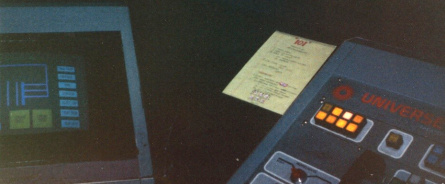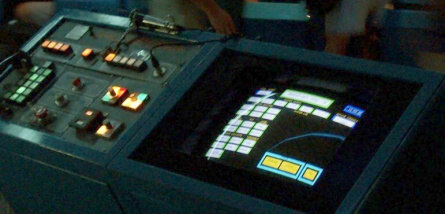 |
Home > Pavilion > Ride/Show Technology > Ride Control System

Note: This article describes the original Ride Control System employed in early EPCOT Center attractions,
including Universe of Energy. While this original "GPRCS" system is no longer in use in Universe of Energy
(and has been all but completely retired elsewhere), it was so ground-breaking that we felt its story deserved
to be told.
Plug 'n Play
One of the most innovative concepts in the "backstage" infrastructure that made EPCOT Center work, owes
to a concept that dates back to the Industrial Revolution: that of interchangeable parts. It seems
so obvious now, we take it for granted. We know that when our car, our computer, or practically anything
else breaks down, there is a ready supply of standardized parts to replace whatever's broken, and get
us back in business. This simple concept (along with the assembly line) also made mass production
feasible, as well as standards in quality control.
Before EPCOT Center, the idea of "interchangeable parts" was largely foreign to the realm of ride control
systems. They may have shared some common components, but the systems built from those components were
mostly custom-designed and built, tailored to a specific attraction. That meant designing, building, testing,
and "debugging" (working out "bugs" or kinks in the system) each ride control system separately--a
time-consuming, arduous, and expensive task. EPCOT Center changed all that, with a system called "GPRCS",
or "General-Purpose Ride Control System". It was exactly what its name implied-a general-purpose system
that could run just about any type of ride system! It wasn't quite "Plug 'n Play", but it did allow a
very big piece of the ride-control puzzle to be more-or-less "dropped into place".

Connecting to the Real World
The ride systems varied widely, from Omnimover systems (Spaceship Earth, World of Motion, Journey Into
Imagination, Horizons) to the ground-breaking and far more complex Traveling Theater in Universe of Energy.
Even the Omnimover systems, while they used basically the same conveyance, had different track layouts, timing,
and other requirements. How could a single machine adapt to all these different requirements? It's much the
same way that your computer adapts to different tasks, from scanning and printing photos, to surfing the
Internet. Your computer is also (more-or-less) a general-purpose machine, which adapts--through software and
hardware--to the task at hand. For example, your computer (or more specifically, the CPU--what some would call
the "brain" of your computer) doesn't deal with the "nuts-and-bolts" of communicating over a phone line.
It lets the modem handle that.Software determines what the data coming in from the modem means, and what to
do with it (display it as text, a picture, etc).
GPRCS--a machine about the size of a modern PC--could be "interfaced" to sensors, motor controllers, and
whatever it needed to manage the ride system--much as your PC "interfaces" with the Internet through a modem.
With GPRCS and the interfaces for controlling various ride system hardware in place, the only remaining piece
of the puzzle is software. Software had to be tailored to each ride, to manage its unique characteristics
and requirements.
The advantage of the GPRCS approach is that it cut development time: standard GPRCS units--rather than
individual, custom systems--could be manufactured for each ride. Testing and "debugging" was reduced,
for once the "bugs" were worked out of the GPRCS design, each unit should perform equally well in every
ride in which it's used. And finally, if a GPRCS unit broke down, it could simply be replaced with another.

Magic Touch
In the "old days" (and sadly, yet again), ride control consoles were cluttered with an array of chunky
pushbuttons, knobs, and indicator lights. The more things that had to be controlled, the more buttons
there had to be. Status information, usually conveyed only through indicator lights (though in some cases
augmented with monitors displaying text messages) was limited. Each console had to be designed for a specific
ride, and each pushbutton, knob, and light had to be "hard wired".
Just as GPRCS revolutionized the "back end" of the ride control system, its sister component, the "DCM" or
"Display Control Module" did the same for the "front end", or operator control console. The DCM embodied the
same "general purpose" concept as GPRCS. It was a standardized component that could be used in any GPRCS-based
ride system. No "hard-wiring", no custom designs, and best of all: no chunky pushbuttons. All the buttons and
indicator lights were replaced with a single, elegant color touch screen.


Like GPRCS, the DCM was adaptable to whatever ride it was placed in. It awaited only the proper software to
bring it to life, customizing it to a particular ride. All the development-time and interchangeability
advantages were there, but the DCM also offered something else. Because the screen could display virtually
anything, there was virtually no limit to the number or type of "buttons" that it could contain, or the ride
data that it could display. To appreciate just how amazing that was, think again of the computer you're
reading this on. If you had to have a separate pushbutton, knob, or switch on your keyboard for every icon,
every Windows "toolbar" button, every possible function that you use--well, let's just say it would be
immense and very difficult to work with! Instead, you have "buttons" on your screen, much as the DCM did.
While we take such things for granted now, it was a quantum leap in technology back in 1982--and curiously,
it hasn't been matched since.
The touch-screen DCM displayed its "buttons" or controls as white or colored squares and rectangles. Just
touching the shape on the screen activated its function. The DCM could display different sets of buttons,
for example, touching one button might bring up a "maintenance screen", filled with arcane controls for
adjusting every part of the ride. Maintenance personnel wouldn't have to go backstage to a centralized
maintenance panel--they could activate maintenance controls from any DCM.
The DCM could also display detailed status information. For example, Universe of Energy's DCM showed a
rough outline of the ride path, indicating the status of the guidewire (the invisible "track" that the
vehicles travel along), the position of the turntables, and status of the show doors (open or closed).
It also could display error messages if there was a problem with the ride, as well as the ride's
operational status ("101" or "102").
For a closer look at the DCM, be sure to visit the Ride Operator Consoles page.

They Shoot GPRCS's, don't they?
 For a system so cleverly designed, and offering such promise, GPRCS and the DCM were surprisingly and sadly
short-lived. The last attraction to be built with GPRCS was Horizons, which has since been demolished. The Living
Seas was the first to be built without it. As best we can determine, GPRCS was subsequently eliminated from
attractions as they were rehabbed (Universe of Energy, World of Motion, Journey Into Imagination, Listen to
the Land, El Rio de Tiempo). These attractions no longer feature DCMs, and we have it on good authority that
GPRCS itself is gone as well. The only remaining attraction with GPRCS and DCM is Spaceship Earth. Sadly, as that
attraction is slated to be replaced with a new attraction called "Time Racers," we will almost certainly see
the end of GPRCS in the near future.
For a system so cleverly designed, and offering such promise, GPRCS and the DCM were surprisingly and sadly
short-lived. The last attraction to be built with GPRCS was Horizons, which has since been demolished. The Living
Seas was the first to be built without it. As best we can determine, GPRCS was subsequently eliminated from
attractions as they were rehabbed (Universe of Energy, World of Motion, Journey Into Imagination, Listen to
the Land, El Rio de Tiempo). These attractions no longer feature DCMs, and we have it on good authority that
GPRCS itself is gone as well. The only remaining attraction with GPRCS and DCM is Spaceship Earth. Sadly, as that
attraction is slated to be replaced with a new attraction called "Time Racers," we will almost certainly see
the end of GPRCS in the near future.
As the DCMs were eliminated, they were replaced with the familiar panels of chunky pushbuttons. The new
panels take up more space than before (remember, a button for every function?), and don't offer nearly
the degree of control of the DCM. Most consoles also feature a 80's-era monochrome monitor displaying
textual status messages. Universe of Energy's new console, now referred to as the Ride Operation Console
(ROC) though inelegant compared to the original, at least features a pretty nifty plasma display showing
the ride layout (in more detail than the DCM's lower-resolution graphics could). However, unlike the on
the DCM, the ride layout on the current ROC screen is not animated and serves no real function.


Details on the demise of GPRCS are sketchy. One Cast Member reported that it was based on "problems with
the company that made them". We're not quite sure what to make of this, as it's our understanding that
GPRCS was made by MAPO, the Disney company that develops much of the hardware for Disney parks. Of course,
even MAPO uses components from other companies--and at least one affected company, Compucolor Corporation
(which made the computers on which the DCMs were based), went out of business around the time that
EPCOT Center opened. It's also possible that because the technology is now more than 20 years old (pre-dating
even the introduction of the IBM PC), it simply is too difficult to maintain or find replacement parts.
While Spaceship Earth's system is still running, it may be doing so on parts scavenged from retired
systems.




Son of GPRCS
The more than two decades since the inception of GPRCS has seen technology expand and improve in leaps
and bounds that the GRPCS' designers likely could never have imagined. An interesting product of the
ever-increasing power, versatility, and diminishing cost of electronics--is a component called a PLC,
or "Programmable Logic Controller". Though not a direct descendant of GPRCS, PLCs embody many of the
same characteristics: they are standardized, general-purpose, programmable control components. They are
now in widespread use in ride control systems--perhaps even in Universe of Energy--so even though
GPRCS itself is all but gone, its pioneering spirit lives on.


Related Pages
Ride Operator Console
Take a more detailed look at the DCM and see how it worked, from the computer on which it was based
to the touch-screen system; then see the system that replaced it.

|
 |
|
|





